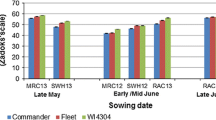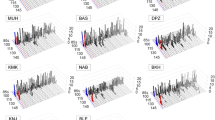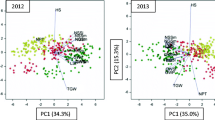Abstract
The purpose of the present work is to validate the effect of the main QTL determining heading date in a set of 281 doubled haploid lines of barley, derived from 17 small interconnected populations, whose parents are cultivars commonly used in the Spanish barley breeding program. We used 72 molecular markers distributed across the seven chromosomes, particularly in regions known to contain flowering time genes or QTL. A combined linkage map over the 17 populations was constructed. The lines were evaluated in four field trials: two autumn sowings and two winter sowings, and in two treatments at a greenhouse trial, under controlled conditions of photoperiod and temperature. We have found that it is possible to carry out QTL detection in a complex germplasm set, representative of the materials used in an active breeding programme. In most cases two alleles per QTL were detected, though polymorphism of flanking markers was notably higher. The results revealed that there is a set of QTL that accounts for an important percentage of the phenotypic variation, suitable for marker assisted selection. Also, the role of the regions carrying the photoperiod response genes Ppd-H1 and Ppd-H2, the vernalization response genes Vrn-H1 and Vrn-H2, and the earliness per se locus Eam6, of which allele-specific or closely linked markers were available, was confirmed. These results support the use of this kind of approach for the validation of QTL found in single cross population studies, or to survey allelic diversity in plant breeding sets of materials.




Similar content being viewed by others
References
Basten CJ, Weir BS, Zeng ZB (1995–1996). QTL Cartographer: a reference manual and tutorial for QTL mapping. Department of Statistics, North Carolina State University, Raleigh, NC
Benjamini Y, Hochberg Y (1995) Controlling the false discovery rate: a practical and powerful approach to multiple testing. J R Stat Soc 57:289–300
Boyd WJR, Li CD, Grime CR et al (2003) Conventional and molecular genetic analysis of factors contributing to variation in the timing of heading among spring barley (Hordeum vulgare L) genotypes grown over a mild winter growing season. Aust J Agric Res 54:1277–1301
Breseghello F, Sorrells ME (2006) Association analysis as a strategy for improvement of quantitative traits in plants. Crop Sci 46:1323–1330
Canci PC, Nduulu LM, Muehlbauer GJ et al (2004) Validation of quantitative trait loci for Fusarium head blight and kernel discoloration in barley. Mol Breed 14:91–104
Casas AM, Igartua E, Vallés MP et al (1998) Genetic diversity of barley cultivars grown in Spain, estimated by RFLP, similarity and coancestry coefficients. Plant Breed 117:429–435
Chen X, Cho YG, McCouch SR (2002) Sequence divergence of rice microsatellites in Oryza and other plant species. Mol Genet Genomics 268:331–343
Christiansen MJ, Feenstra B, Skovgaard IM, Andersen SB (2006) Genetic analysis of resistance to yellow rust in hexaploid wheat using a mixture model for multiple crosses. Theor Appl Genet 112:581–591
Crepieux S, Lebreton C, Servin B et al (2004) Quantitative trait loci (QTL) detection in multicross inbred designs: recovering QTL identical-by-descent status information from marker data. Genetics 168:1737–1749
Crepieux S, Lebreton C, Flament P et al (2005) Application of a new IBD-based QTL mapping method to common wheat breeding population: analysis of kernel hardness and dough strength. Theor Appl Genet 111:1409–1419
Cuesta-Marcos A, Igartua E, Ciudad FJ, Codesal P, Russell JR, Molina-Cano JL, Moralejo M, Szűcs P, Gracia MP, Lasa JM, Casas AM. Heading date QTL in a spring × winter barley cross evaluated in Mediterranean environments. Mol Breeding (submitted)
Dubcovsky J, Loukoianov A, Fu D et al (2006) Effect of photoperiod on the regulation of wheat vernalization genes VRN1 and VRN2. Plant Mol Biol 60:469–480
Estoup A, Jarne P, Cornuet JM (2002) Homoplasy and mutation model at microsatellite loci and their consequences for population genetics analysis. Mol Ecol 11:1591–1604
Flint-Garcia SA, Thornsberry JM, Buckler IV ES (2003) Structure of linkage disequilibrium in plants. Annu Rev Plant Biol 54:357–374
Francia E, Rizza F, Cattivelli L et al (2004) Two loci on chromosome 5H determine low-temperature tolerance in a ‘Nure’ (winter) × ‘Tremois’ (spring) barley map. Theor Appl Genet 108:670–680
Franckowiak JD, Gallagher LW (1997) Early maturity locus symbol: eam7. Barley Genet Newsl 26:233
Franckowiak JD, Konishi T (2002) Early maturity 6, Eam6. Barley Genet Newsl 32:86–87
Horsley RD, Schmierer D, Maier C et al (2006) Identification of QTLs associated with Fusarium head blight resistance in barley accession CIho 4196. Crop Sci 46:145–156
Jannink JL, Jansen RC (2001) Mapping epistatic quantitative trait loci with one-dimensional genome searches. Genetics 157:445–454
Jansen RC (1993) Interval mapping of multiple quantitative trait loci. Genetics 135:205–211
Jansen RC, Stam P (1994) High resolution of quantitative traits into multiple loci via interval mapping. Genetics 136:1447–1455
Jansen RC, Jannink JL, Beavis WD (2003) Mapping quantitative trait loci in plant breeding populations: use of parental haplotype sharing. Crop Sci 43:829–834
Kane NA, Danyluk J, Tardif G, Ouellet F, Laliberte JF, Limin AE, Fowler DB, Sarhan F (2005) TaVRT-2, a member of the StMADS-11 clade of flowering repressors, is regulated by vernalization and photoperiod in wheat. Plant Physiol 138:2354–2363
Karakousis A, Gustafson JP, Chalmers KJ et al (2003) A Barley consensus map integrating SSR RFLP, and AFLP markers. Aust J Agric Res 54:1173–1185
Karsai I, Szűcs P, Mészáros K et al (2005) The Vrn-H2 locus is a major determinant of flowering time in a facultative × winter growth habit barley (Hordeum vulgare L) mapping population. Theor Appl Genet 110:1458–1466
Kjaer B, Jensen J, Giese H (1995) Quantitative trait loci for heading date and straw characters in barley. Genome 38:1098–1104
Komatsuda T, Li W, Takaiwa F et al (1999) High resolution map around the vrs1 locus controlling two-rowed and sixrowed spike in barley, Hordeum vulgare. Genome 42:248–253
Kóti K, Karsai I, Szűcs P et al (2006) Validation of the two-gene epistatic model for vernalization response in a winter × spring barley cross. Euphytica 152:17–24
Laurie DA, Pratchett N, Bezant JH et al (1994) Genetic analysis of a photoperiod response gene on the short arm of chromosome 2 (2H) of Hordeum vulgare. Heredity 72:619–627
Laurie DA, Pratchett N, Bezant JH et al (1995) RFLP mapping of five major genes and eight quantitative trait loci controlling flowering time in a winter × spring barley (Hordeum vulgare L) cross. Genome 38:575–585
Liu Y, Zeng ZB (2000) A general mixture model approach for mapping quantitative trait loci from diverse cross designs involving multiple inbred lines. Genet Res 75:345–355
Macaulay M, Ramsay L, Powell W et al (2001) A representative, highly informative ‘genotyping set’ of barley SSRs. Theor Appl Genet 102:801–809
Melchinger AE, Utz HF, Schön CC (2004) QTL analyses of complex traits with cross validation, bootstrapping and other biometric methods. Euphytica 137:1–11
Moralejo M, Swanston JS, Muñoz P et al (2004) Use of new EST markers to elucidate the genetic differences in grain protein content between European and North American two-rowed malting barleys. Theor Appl Genet 110:116–125
Muranty H (1996) Power of tests for quantitative trait loci detection using full-sib families in different schemes. Heredity 76:156–165
van Ooijen JW, Voorrips RE (2001) JoinMap® 3.0, Software for the calculation of genetic linkage maps. Plant Research International, Wageningen, Netherlands
van Oosterom EJ, Acevedo E (1992) Adaptation of barley (Hordeum vulgareL) to harsh Mediterranean environments III. Plant ideotype and grain yield. Euphytica 62:29–38
Pan A, Hayes PM, Chen F et al (1994) Genetic analysis of the components of winterhardiness in barley (Hordeum vulgare L). Theor Appl Genet 89:900–910
Pillen K, Binder A, Kreuzkam B et al (2000) Mapping new EMBL-derived barley microsatellites and their use in differentiating German barley cultivars. Theor Appl Genet 101:652–660
Rae SJ, Keith R, Mackie A et al (2006) Small cross mapping of barley quality characters. Eucarpia meeteing, Cereals Section, Lleida, Spain, November 13–17
Ramsay L, Macaulay M, degli Ivanissevich S et al (2000) A simple sequence repeat-based linkage map of barley. Genetics 156:1997–2005
Rebaï A, Goffinet B (2000) More about quantitative trait locus mapping with diallel designs. Genet Res 75:243–247
Rostoks N, Mudie S, Cardle L et al (2005) Genome-wide SNP discovery and linkage analysis in barley based on genes responsive to abiotic stress. Mol Gen Genomics 274:515–527
Sakamoto Y, Ishiguro M, Kitagawa G (1986) Akaike information criterion statistics. KTK Scientific Publishers, Tokyo, pp 83–85
Schwarz G (1978) Estimating the dimension of a model. Ann Statistic 6:461–464
Stracke S, Börner A (1998) Molecular mapping of the photoperiod response gene ea7 in barley. Theor Appl Genet 97:797–800
Swanston JS, Russell JR, Pérez-Vendrell AM et al (2006) Efficient selection of β-glucan content enhances wider utilisation of barley grain. Eucarpia meeteing, Cereals Section, Lleida, Spain, November 13–17
Szűcs P, Karsai I, von Zitzewitz J, Cooper L et al (2006) Positional relationships between photoperiod response QTL and photoreceptor and vernalization genes in barley. Theor Appl Genet 112:1277–1285
Szűcs P, Skinner JS, Karsai I et al (2007) Validation of the VRN-H2/VRN-H1 epistatic model in barley reveals that intron length variation in VRN-H1 may account for a continuum of vernalization sensitivity. Mol Genet Genom doi: 10.1007/s00438-006-0195-8
Trevaskis B, Hemming MN, Peacock WJ et al (2006) HvVRN2 Responds to daylength, whereas HvVRN1 is regulated by vernalization and developmental status. Plant Physiol 140:1397–1405
Turner A, Beales J, Faure S et al (2005) The pseudo-response regulator Ppd-H1 provides adaptation to photoperiod in barley. Science 310:1031–1034
Varshney RK, Graner A, Sorrells ME (2005) Genomics-assisted breeding for crop improvement. Trends Plant Sci 10:621–630
Verhoeven KJ, Jannink JL, McIntyre LM (2006) Using mating designs to uncover QTL and the genetic architecture of complex traits. Heredity 96:139–149
Wenzl P, Li H, Carling J et al (2006) A high-density consensus map of barley linking DArT markers to SSR, RFLP and STS loci and agricultural traits. BMC Genomics 7:206–215
Xu SZ (1998) Mapping quantitative trait loci using multiple families of line crosses. Genetics 148:517–524
Yan L, Loukoianov A, Tranquilli G et al (2003) Positional cloning of the wheat vernalization gene VRN1. Proc Natl Acad Sci USA 100:6263–6268
Yan L, Loukoianov A, Blechl A et al (2004) The wheat VRN2 gene is a flowering repressor down-regulated by vernalization. Science 303:1640–1644
Yan L, Fu D, Li C et al (2006) The wheat and barley vernalization gene VRN3 is an orthologue of FT. Proc Natl Acad Sci USA 103:19581–19586
Zeng ZB (1994) Precision mapping of quantitative trait loci. Genetics 136:1457–1468
von Zitzewitz J, Szűcs P, Dubcovsky J et al (2005) Molecular and structural characterization of barley vernalization genes. Plant Mol Biol 59:449–467
Acknowledgements
This work was supported by the Spanish Ministry of Education and Research (Projects AGL2001-2289, including a scholarship granted to Mr. Alfonso Cuesta-Marcos, and AGL2004-05311) and by the European Regional Development Fund. The authors appreciate the critical reading of the manuscript by Prof. Steve Ullrich, and the valuable suggestions of two anonymous reviewers.
Author information
Authors and Affiliations
Corresponding author
Electronic supplementary material
Rights and permissions
About this article
Cite this article
Cuesta-Marcos, A., Casas, A.M., Yahiaoui, S. et al. Joint analysis for heading date QTL in small interconnected barley populations. Mol Breeding 21, 383–399 (2008). https://doi.org/10.1007/s11032-007-9139-1
Received:
Accepted:
Published:
Issue Date:
DOI: https://doi.org/10.1007/s11032-007-9139-1




